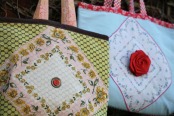Yikes, it’s been far too long since I’ve posted a blog update! I’ve been so focused on building my newsletter that I’ve put the blog on the backburner (it’s hard to do lots of different things well, I’ve found). But I did want to pop in and let readers know about something very cool I’m organizing.
I’ve been thinking lately how people can make a splash with their brand: how do you get your ideas out there into the world? We know how big companies do it (with huge marketing budgets and staffs of people). But what about solopreneurs, Etsy shop owners, fabric designers, and other creative types? You’ve got ideas too!  That’s why I’m organizing a “telesummit”: Expand Your Influence: A Virtual Conference on Turning Big Ideas into Brand Extensions (March 19 – 23) is an interview series all about brand extensions—larger projects like books, eBooks, videos, and TV shows that help you get your big idea out there into the world. It’s going to be energetic and insightful, and totally multidisciplinary (from sports psychology to fabric design!). Speakers range from designer and author Amy Butler to TV show host and designer Angelo Surmelis to self-publishing guru Peter Bowerman, and a whole lot more, like a literary agent (who specializes in craft books), a business coach, and business owners/bloggers who leveraged their brand/blog to write books and sell fantastic branded products. You’ll not only come away from this interview series inspired to create something amazing, you’ll also learn practical tips for marketing your brand extension.
How do you listen? Well, it couldn’t be easier, because it’s free. And it only requires signing up. You can listen live, completely free (calls are at 10:00 a.m. and 2:00 p.m. EST each day). Register here. Share this link with anyone you’ve ever heard say they have a big idea.Oh, and I almost forgot: Amy Butler (who you are definitely going to want to hear from) is also offering a book giveaway when you sign up! (Details are on the sign-up page)
So, I’m obviously not doing this because I heart technology (did you read my newsletter last week?). So, what’s the deal? First, I am a geek and I want to study some things, publicly: how the splash happens (what Malcolm Gladwell calls “the tipping point”), what remarkability has to do with it (what Seth Godin calls “the purple cow”), and why starting with “why” always matters (Simon Sinek). But it’s not just about great thinkers I admire. It’s about action. And learning from others’ actions. (I sort of want to take over the world, so there are a few things to learn.)
It’s also a chance to interview superbly cool and extremely brilliant people who are doing inspiring, revolutionary, and/or intriguing things with their brand extensions. Basically, I love the flow of a good conversation. I want to do backstrokes in it. I used to only get to interview cool people when I was writing an article for someone else. Now, I’m doing it for me—and definitely for you.
So sign up, right here!
I love skirts in the summer, and in my dream life, I would make a skirt a week! But my skirt-making time is limited these days. Still, I had time to make this one, based on the Saturday Afternoon Skirt in my book. I actually intended to make the A-line pattern. But once I cut it out, I realized that the home dec fabric I picked out (Amy Butler’s “Trumpet Flowers”) was too heavy and didn’t look right as an A-line. It was much better suited as a straight skirt, with a full ruffle at the bottom. So, I followed the directions in my book, but instead of angling the side seams out on each side, I just made the seamline go more straight down from the hips. 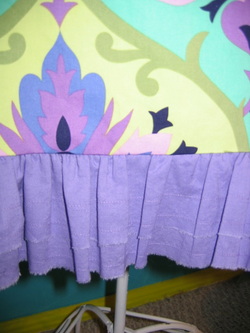 For the ruffle, I used a quilter’s cotton broadcloth from Jo-Ann’s. I wanted the ruffle to be extra full, so I made it two layers (the top one is 3 inches long and the bottom is 4 inches). To get the measurements, I measured around bottom of skirt and doubled it, to allow for gathering. I think that was about 90 inches, but since I was seaming together two complete widths of the fabric, which was more like 43 or 44 inches, the final circumference wound up being more like 86 or 87 inches, which is fine.Some more specifics:
- Since I wanted raw edge, I ripped my pieces. To rip, you just make a little cut at the selvedge and then start ripping. It will rip straight, and it gives a really nice evenly frayed edge. (Always rip a straight line first.) I ripped four pieces across the full width: two pieces that are 3-inches by 44-inches (or whatever the width wound up being after washing) and two pieces that are 4 inches by 44 inches.
- It’s easiest to layer the pieces and take the side seams at the same time. Place each 3-inch piece on top of each 4-inch piece and stitch together at each end (right sides together, so 3-inch piece to 3-inch piece). You’re creating one big circle.
- I wanted some stitching detail on the ruffles for a textured look, so I took a few rows of straight stitches (two rows on the top layer about one row on the bottom layer).
- Then I pinned the layers together at the top and took a gathering stitch. I started at one side seam, stopped he stitching when I got to the other side seam and then resumed on the other side of the seam.
- Then, with right sides together, I matched the side seams on the ruffle and skirt and starting gathering. I evened out the gathers, pinned, and stitched.
- It takes a good pressing to make the ruffle lie flat. I love the finished effect and the fullness of the ruffle layers.
My randomly chosen winner is Melody Alexander! Congrats, Melody! I'll be emailing you shortly.
Thanks everyone for participating. I enjoyed reading everyone's comments about how Amy has inspired you, and I know she will enjoy reading them too!
Have a lovely Thanksgiving!
And I'll be back after the holiday with another giveaway, so stay tuned . . .
Oh, Amy Butler . . . where to begin? I have loved Amy Butler since I discovered her a few years ago when I was getting re-energized about sewing. I think it was on ReproDepot.com where I first laid eyes on her designs, and I was hooked. When I found out she lived in my very own state of Ohio, I was doubly excited. Not only does Amy design the most gorgeous fabric and super-clever patterns, she also makes me appreciate my life in the Midwest and the beauty and pace of life here. In fact, she makes me proud to be a Midwestern girl. I was absolutely giddy the day she agreed to do a Q&A with me for Sew Retro. 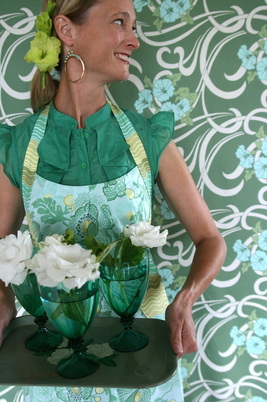 Courtesy Amy Butler But no Q&A is complete without a giveaway! Not only am I giving away a signed copy of Sew Retro, the folks at Amy Butler have generously donated some lovely goodies, including:
-- Five half-yard cuts, all from Amy’s Midwest Modern collection
-- Five Amy Butler Midwest Modern sewing patterns: Cabo Halter, High Street Messenger Bag, Oval Patchy Pillow, Sweet Harmony Handbag & Tote, and Reversible Sunday Sling.
To enter, leave a comment about how Amy has inspired you by Tuesday, November 23rd at noon EST. I’ll randomly choose a winner then.
Now the Q&A, direct from the pages of Sew Retro . . .
Fabric designer and book author Amy Butler has an amazing line of fabric, patterns, and stationary full of hipster florals, modern paisleys, and vintage-inspired prints. I love her fabric because it’s affordably priced and is a great blend of country chic and mid-century modern. Here, she explains how she fell in love with fabric and where she gets her ideas.
Q: What made you become interested in fabric and pattern design? Have you always liked textiles?
Butler: My passion for fabrics and sewing has been a common thread through the span of my life. I realized I wanted to become an artist when I was a young girl and learned what the word artist meant. I was always coloring and crafting and making homemade gifts for friends and family.
My grandmother, Velma Heymann, gave me my first fabric stash at age six. She’d let me play around on her “not so nice” vintage sewing machine, where I learned the basics. It was in her attic sewing room that I first fell in love with fabric; its colors and textures gave me limitless inspiration.
As a teen, I focused my energies and enrolled in art school. There I worked hard to hone my skills without losing that sense of intrigue and passion—exploring shapes, colors, textures, and style. Surface design and fashion became my obsession. I would draw enormously tall women with impossible necks, and on them I would create lavish, layered clothing. Within those layers, I would doodle in signature florals, patterns, stripes, and modern geometrics. I found that the passionate creation of the print outweighed my love of the clothing, so I focused my efforts on surface design.
In 1997 my husband and I started producing lifestyle stories for Country Living magazine alongside our studio work. The magazine was short on space, but we needed to get instructions to our readers so they could make up the projects. I designed my first two sewing patterns for Country Living, and this is how Amy Butler Sewing Patterns began.
Q: Do you come from a family of sewers and crafty people? Did you grow up watching women around you sew or be creative in other ways?
Butler: My mom and grandmother, both self-taught artists, were huge influences on me. As a child of the seventies, I watched both of them dabble and often master every craft. They created watercolor paintings, hooked rugs, knitted, quilted, made groovy dioramas with found antique artifacts, and dried flowers—truly making our home a creative nest. My grandmother always kept me supplied with craft materials. I took my first fabric stash and glued together halter tops for my little friends in my neighborhood because I didn’t have a sewing machine at home. It was all about the fabric, and the giving. My friends tried to wear the outfits and assured me it was the thought that counted—a comment I still often get, since I love to experiment on my friends with new ideas.
Q: Where do you find your ideas for the beautiful designs you create?
Butler: My influences and inspiration change constantly, but I do have a few core influences. Broadly, all decorative arts and textiles have greatly influenced my work; I love many different time periods and genres and often tie multiple influences together with the different color palettes I use. Growing up, our home was always filled with animals, and my mother taught me a great deal about wildflowers and birds. Natural influences are a constant in my work. My grandmother was also a prolific gardener, which has been a steady influence in all of my work, and today my garden is one of my most satisfying creative outlets. My home life and my surroundings play a big part in feeding my design inspiration. They are interconnected, and one feeds the other.
Q: What attracts you to vintage fabrics?
Butler: I grew up learning about and loving all things old. My mom and grandma always dragged me to auctions and flea markets—which I grew to love—so I’ve always made my home and dressed with vintage textiles and garments. I love vintage fabrics because the prints are so soulful and unique and one of a kind. Over the years they have become a centerpiece for my visual vocabulary.
Q: Who are some of your influences, from an artistic standpoint?
Butler: The top of my list is my husband, David. He is a massive talent. He’s a true renaissance man, as he’s a brilliant fine artist, writer, photographer, and graphic designer. His body of work is so impressive. He is true to himself and his art, and that’s what moves me the most.
Kaffe Fasset has always been a great inspiration to me. I admire him because he is a fine artist who eloquently shares his vision for color and design through his work with great warmth and passion. I get lost in the color combinations in his fabrics!
I am also a huge admirer of Harmony Susalla from Harmony Arts. Harmony is leading the way for organic printed fabrics. She is the real deal, an amazing artist, designer, and passionate supporter for the organic fabric movement. She is a visionary with an unwavering heart, and her fabrics are delicious!
I’m constantly inspired by Tricia Guild’s philosophy and her spirited use of color and print. Her designs are sophisticated and approachable at the same time. I love her books, they are put together so beautifully . . . a total feast for the eyes!
Q: Why do you think sewing is enjoying a resurgence in popularity among younger women?
Butler: The retail/design world is so sophisticated, and with the addition of the Internet, young women have a heightened sense of style. I think they’re coming into fabric stores and quilt shops where they can find new products, and are then introduced to the special experience of great education, service, and inspiration that’s been so successfully nurtured by these retailers. Once their creative fire has been sparked, they can’t help developing a desire for sewing! I think it’s an exciting time, with a huge influx of wonderful new designers and products hitting shops. I think we are seeing a new direction where fabric shops and quilt shops are becoming more multi-generational, appealing to their current customer base while also attracting a new, beginner seamstress.
|

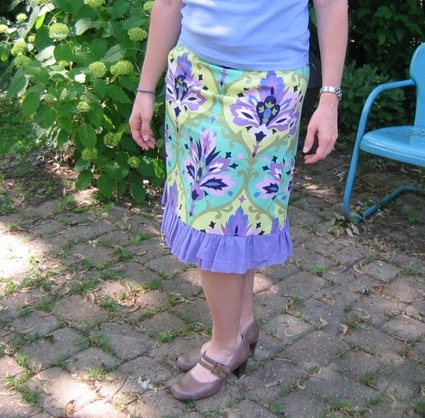
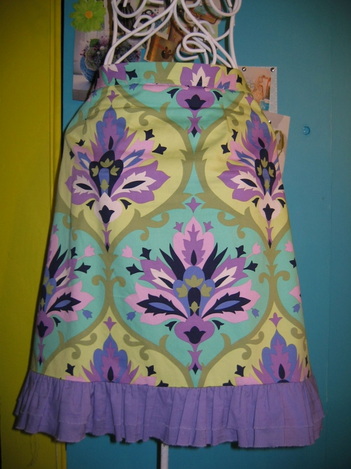

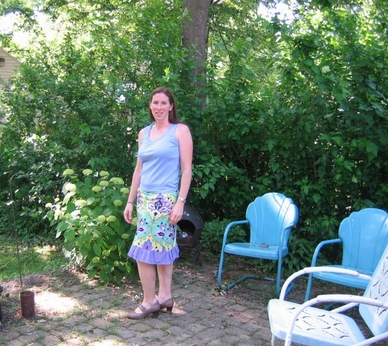

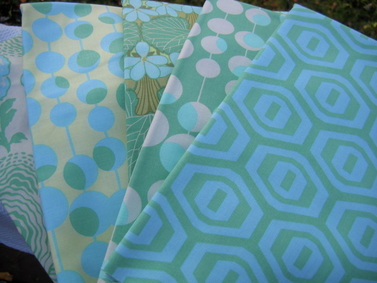
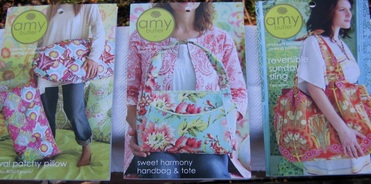
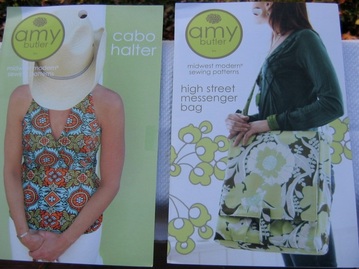
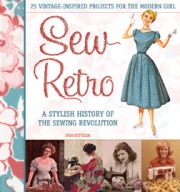

 RSS Feed
RSS Feed